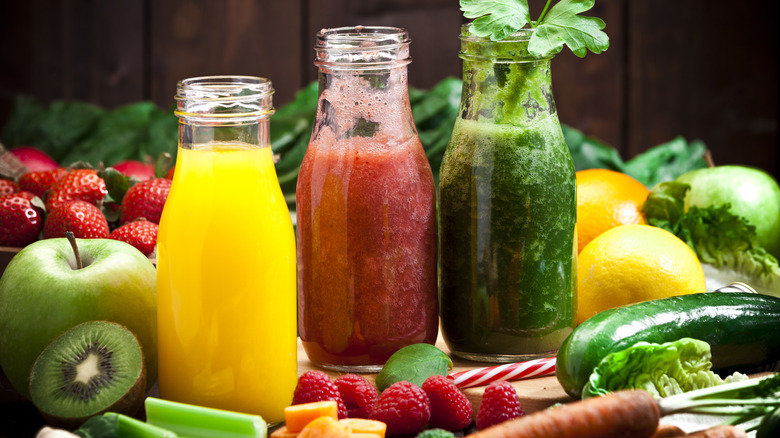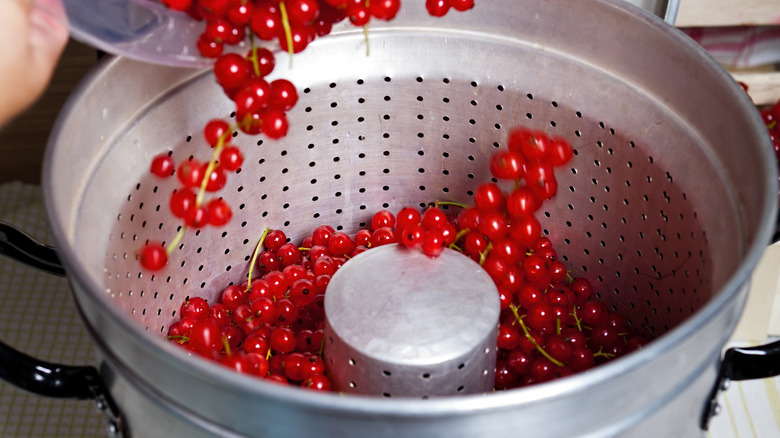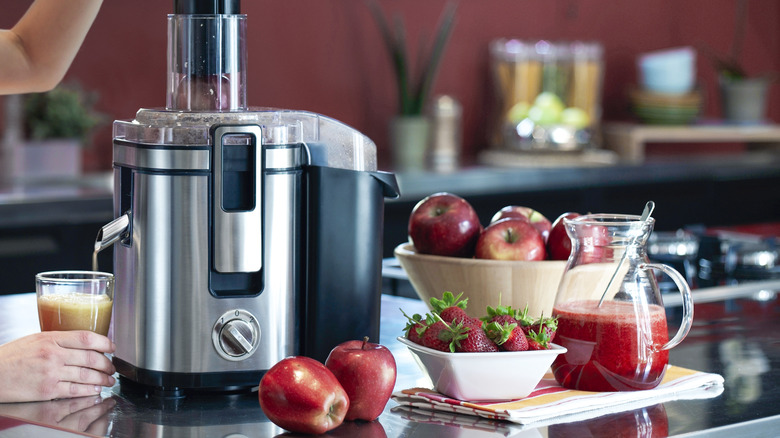The Two Key Methods For Making Fresh Fruit Juice
In recent years, juicing has taken the culinary and health worlds by storm. Drinking fruit and vegetable juice can be a quick, easy way to incorporate lots of vitamins and health benefits into a diet, and there's more juice options than ever. From a nutritious, crisp, and gingery green juice to a juiced-up cocktail, juice is a versatile ingredient that packs a flavorful punch. With so many varieties, it's no wonder that there's many ways to get juice from produce.
The most common juicing methods are steam juicing and cold press juicing, and there are benefits to each practice. If you want fast and easy juice in big batches, or a less labor-intensive juicing method for canning, steam juicing is right for you. If you want to pack a drink full of health benefits like vitamins and antioxidants, and don't mind waiting a little longer or spending a little more, then cold press juicing is the way to go. Both practices yield yummy juice, so think about what you're hoping to get out of your juice before deciding which type of juice is right for you.
Steam juicing 101
Have you ever wondered how a solid orange became the citrusy, tangy juice in the bottle at your breakfast table? What about the sweet apple drink you drank from a juice box as a kid? These grocery store favorites likely come from the steam juicing method, because steam juicing helps preserve juice, and makes it safe to drink for longer periods of time.
From bottled juices in the refrigerated aisle to canned fruit juices used for cooking and baking, the steam juicing method works well for large-scale production, creating long-lasting juice, but it's not just for store bought products. With your own steam juicer, you can make fresh juice right in your kitchen.
Steam juicers work by boiling water to create scalding steam that breaks down produce cells, effectively bursting the fruit. Then, the steam juicer collects juice as it drips from the burst fruit pulp. This method is fast and easy with minimal cleanup afterwards. Heat from the steam essentially cooks the fruit juice as well, making it immediately ready to can, and increasing its shelf stability. Steamed juice lasts longer than fresh, live juice with active enzymes, because hot steam from the juicing process kills all the enzymes from the fruit. This makes fresh steamed juice perfect for canning, storing, or using for jams and jellies.
Cold press juicing basics
Cold press juicing, also called masticating juicing, is likely the method you imagine when you think about juicing. If you've ever juiced a lemon by squishing it, you've basically used the cold press method. Unlike centrifugal juicing, which is essentially blending produce and straining the resulting juice, or steam juicing, cold press juicing doesn't heat or oxidize the liquid. This process is as simple as using force to crush fruit and vegetables, thereby squeezing out the juices inside.
The greatest benefit to cold press juicing is the increased nutritional value. This method doesn't heat or cook the juice, meaning that all of the active enzymes are still intact. Cold pressed juice has more vitamins and antioxidants than steamed juice, so it's the best option if you're looking to maximize health benefits — just make sure you drink it fast, because live juice will spoil faster than steamed juice.
Of course, twisting lemons over a conical plastic juicing tool, or manually cranking down a juice press, can be physically tiring and time consuming. Automatic cold press juicers often use hydraulics and an auger to smash produce against a sieve, but they can be costly, and still take longer than other juicing methods. For cold press juicing, try the NutriBullet Slow Juicer, top pick for a juicer in the 2023 Tasting Table Awards. Now that you have the basics, you can make the best choice for all of your juice needs.


